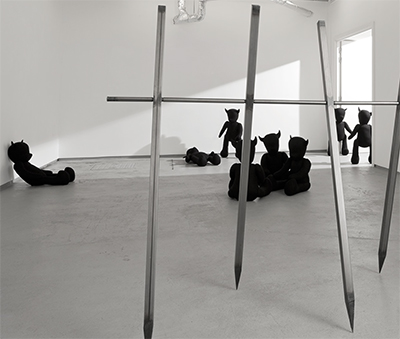
Ten Teddies and Barrier, 2017
Permindar Kaur: Nothing is Fixed
Amna Malik
A fur-covered frame faces me, a metal claw protrudes from within, a sign nearby instructs the viewer ‘Please do not touch’, which, oddly, is just what this work entices us to do. The ensuing ‘object-pictures’ that we encounter by Permindar Kaur further a certain ambivalence where the desire to caress and stroke is coupled with a latent menace that wards us off. The artist’s work over the past 30 years or more has often incorporated figures cut out of felt in primary colours and adorned with metal helmets, boots, claws, talons and horns. Here, her exploration of both the child’s toy and the child as toy is further transformed in the series ‘Camouflage’, 2012–13. Attached to the gallery walls is a series of singular figures on patterned and cloth- covered frames. By inserting the surrealist uncanny into these instances of the painting-as-object, Kaur brings to mind Andy Warhol’s ‘paint-by-numbers’ works, Sonia Boyce’s William Morris-patterned pastels and even Ellsworth Kelly’s shaped frames. In Kaur’s painting-objects the primary material is cloth, conveying camouflage in tension between figure/ground, silhouette and surface, suggestive of a child’s toy but most often appearing as a hollow space over a stretched fabric frame. Neither a portrait nor a sculpture, the resulting object becomes an oscillation between both.
Arranged across a single wall, Kaur’s customary implosion of the white cube into a domestic space riven by the uncanny here shifts towards a self-referential play on figure and ground, texture and surface. Kaur’s signature felt-fashioned diminutive figure, previously seen in serial structures on walls, sometimes with small daggers, shifts in this exhibition to become a single figure at the end of the display. In this changed context, the single figure, coming after the play on interior domestic surfaces, brings to mind the prominent late 19th-century German educationalist Daniel Gottlieb Moritz Schreber, who designed prosthetic instruments to control school children, but which are really tools of torture and imprisonment. Father to Daniel Paul Schreber, whose memoirs would be studied by Sigmund Freud and others, these documents, which were examined by Eric L Santner in his 1996 study My Own Private Germany: Daniel Paul Schreber’s Secret History of Modernity, grant an insight to an imperialist mindset that was excessively projected onto the taming of the child as the focus of cultural anxieties about savagery. The US psychoanalyst, William Niederland, published a study of Moritz Schreber, in the 1950s, revealing the latter’s status as a renowned author. Kallipädie from 1858 advocated rearing of the child to instil Enlightenment values of reason from within, based on absolute obedience to the father, underpinned by Christian belief. Niederland argued that Moritz Schreber’s theories, based on instilling habit through repetition of the body, and his creation of orthopaedic devices to enforce correct posture, were the products of a sadistic personality that produced his son’s psychotic personality and his eventual breakdown. His argument would inform Elias Canetti, Gilles Deleuze and Félix Guattari’s interest in the Schreber case as an example of connections between power and paranoia that result in fascism.
In Kaur’s art, filtered through Surrealism, the figure of the child is neither gendered nor anatomically specific; rather, these objects become generic of the world of the child, redolent of emptiness and loss. This absence, as much as the small scale of the figure,
is suggestive of a certain nostalgia, one that was examined by Susan Stewart, who viewed the child’s toy as a reproduction of the adult in miniature to be played with. The often utilitarian objects that are transformed through ‘child’s play’ into toys is revealed by Kaur as the interiorised space of dreams and fantasies.
The memory of childhood as a source of trauma or nostalgia remains unresolved in Kaur’s exhibition because one is set against the other; felt skirts that adorn miniature chairs, for example, implicitly gender the world of a doll’s house. Set on plinths they recall Alberto Giacometti’s The Palace at 4am, 1930–32, indicating a shift from the large-scale bunk beds in the former gallery to the now miniaturised world of the Victorian doll’s house as a collector’s item, albeit one wrenched from its ornate interiors. Towards the end of the gallery, a single chair faces away from the works that precede it and towers above them – a totemic object or a play on the monument? Throughout the exhibition, one encounters a sense of alienation, of the subject who does not fit, whose presence is always either diminished or grotesquely oversized and dominant. Such vastly contrasting scales and materials play with the phenomenological associations of sculpture and domesticity in relation to the spectator’s body.
In one corner of the gallery, the home as the source of aggression is evoked in a mass of organic forms, including small felt heads sprouting horns beneath a metal framed bed that is suggestive of discomfort and disconnection. Similarly, in another gallery, the walls and floors have been painted black and are spot lit to reveal a drama of social upheaval through a series of black teddies, arranged in different ways: piled up in a metal cage and then in smaller groups, as though connecting or attempting to connect. It’s impossible not to think of migrant subjects and histories: of small bodies washed up on beaches far from home, or of homes in Gaza ripped apart by bombs – children forced to become adults to care for even smaller children.
Amna Malik is an independent scholar based in London.
Amna Malik, Nothing is Fixed, Art Monthly, London no. 478, pg 28, July – August 2024
Review of Nothing is Fixed, John Hansard Gallery, Southampton. June 8 – Sept 7 2024
ISSN: 0142-6702